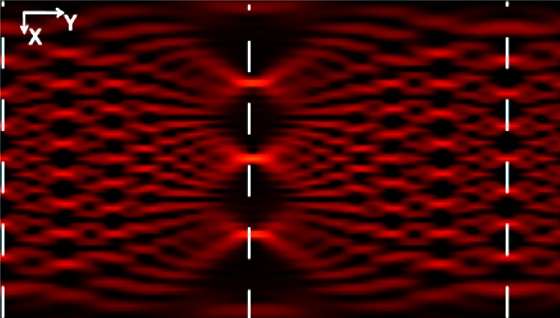July 28, 2017 feature
Optical lens can transfer digital information without loss

(Phys.org)—Researchers have designed an optical lens that exhibits two properties that so far have not been demonstrated together: self-focusing and an optical effect called the Talbot effect that creates repeating patterns of light. The researchers showed that the combination of these two properties can be used to transfer an encoded digital signal without information loss, which has potential applications for realizing highly efficient optical communication systems.
The scientists, Xiangyang Wang and Hui Liu at Nanjing University, Huanyang Chen at Xiamen University, along with their coauthors, have published a paper on the new lens, called a "conformal lens," in a recent issue of Physical Review Letters.
This type of a conformal lens, which is also known as a Mikaelian lens, arose from the field of transformation optics, which is based on the idea that lenses can direct light in analogy with how the curved geometry of spacetime bends light in general relativity.
The main goal of the study was to design a conformal lens that works simultaneously in two different regimes: the geometry optics regime, in which light is treated as a particle, and the wave optics regime, which also accounts for the wave-like properties of light.
Working in both regimes is challenging because the two regimes have two seemingly opposing requirements for the size of the working wavelengths. On one hand, the working wavelengths must be much smaller than the size of the lens, but at the same time they must be larger than the basic units that make up the lens.
To address this challenge, the researchers started with a Maxwell's fish-eye lens, which dates back to the 1850s, as the basis for the conformal lens. They explained that trying to realize a lens with the desired properties using conventional transformation optics is very challenging, in part due its demands on a three-dimensional medium. On the other hand, conformal transformation optics places demands on a two-dimensional medium, which eases the fabrication requirements.
"Although transformation optics can be used to design many novel optical devices, it is usually very difficult to use in practical systems, especially in the visible regime," Liu told Phys.org. "In our work, we have established a feasible experiment platform to obtain conformation transformation optical devices."
After constructing the conformal lens, the researchers demonstrated that the lens exhibits both self-focusing, which is a property of geometric optics, and the Talbot effect, which is a property of wave optics. In this way, the device connects the two distinct realms of geometry optics and wave optics.
Most interesting for potential applications is that the conformal Talbot effect displayed here is very different from the ordinary Talbot effect in other media due to the additional self-focusing property. One of the biggest differences is that, unlike the ordinary Talbot effect which experiences boundary diffraction, the conformal Talbot effect does not.
As a result of its lack of diffraction, the conformal Talbot effect can be used to transfer encoded optical patterns over long distances with a very small amount of distortion. The researchers expect that this ability could lead to a highly efficient method of transferring digital information in future high-speed optical communication systems with no information loss.
"We can send a stream of optical digits '0' and '1' by parallel communication, which is much faster than the serial communication used in regular optical waveguides or optical fibers," Liu said. "The conformal Talbot effect can help reduce transmission errors because of its non-diffractive properties and good self-focusing of the field patterns."
In the future, the researchers plan to explore various potential applications of conformal transformation optics, such as designing novel integrated photonic chips that can transport and process information in micro-optical circuits. These "conformal photonic chips" may one day be used in future quantum computers.
"We hope conformal transformation optics can be used in quantum simulators and quantum computers in the future," Chen said. "We also plan to mimic the quantum effects in the curved space of general relativity using conformal transformation optics, such as the horizon of a black hole and Hawking radiation."
More information: Xiangyang Wang et al. "Self-Focusing and the Talbot Effect in Conformal Transformation Optics." Physical Review Letters. DOI: 10.1103/PhysRevLett.119.033902
Abstract
Transformation optics has been used to propose various novel optical devices. With the help of metamaterials, several intriguing designs, such as invisibility cloaks, have been implemented. However, as the basic units should be much smaller than the working wavelengths to achieve the effective material parameters, and the sizes of devices should be much larger than the wavelengths of illumination to work within the light-ray approximation, it is a big challenge to implement an experimental system that works simultaneously for both geometric optics and wave optics. In this Letter, by using a gradient-index microstructured optical waveguide, we realize a device of conformal transformation optics (CTO) and demonstrate its self-focusing property for geometry optics and the Talbot effect for wave optics. In addition, the Talbot effect in such a system has a potential application to transfer digital information without diffraction. Our findings demonstrate the photon controlling ability of CTO in a feasible experiment system.
Journal information: Physical Review Letters
© 2017 Phys.org

















